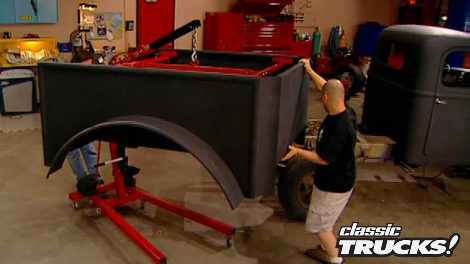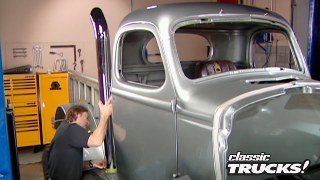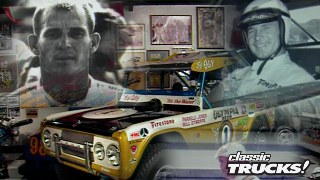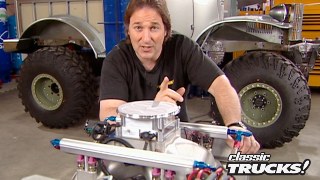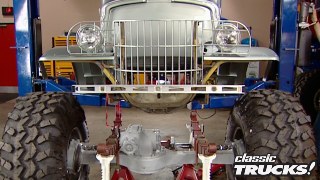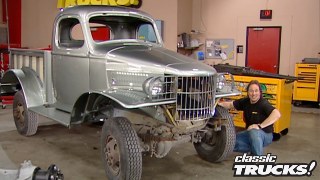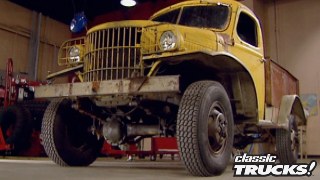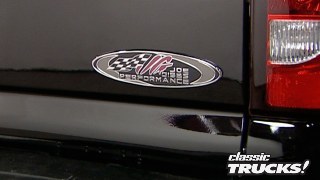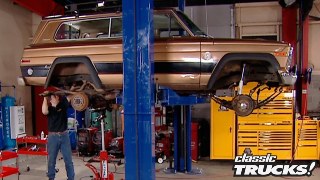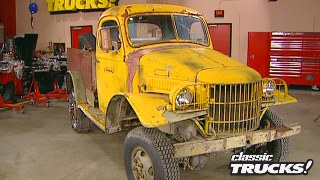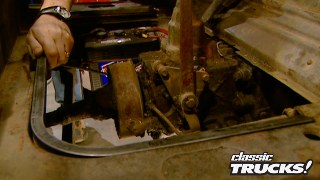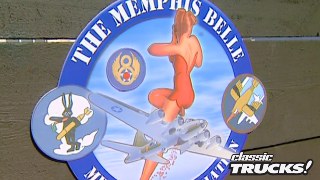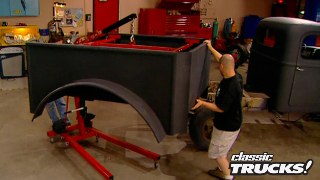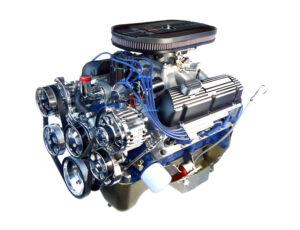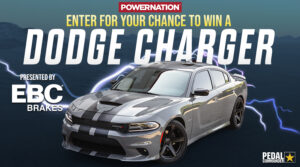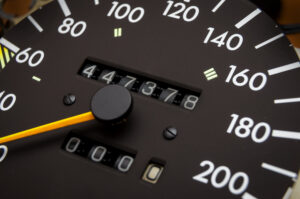More Sergeant Rock Episodes
Classic Trucks! Builds
Want more content like this?
Join the PowerNation Email NewsletterVideo Transcript
Welcome to trucks. We've got an awesome show for you today because I'm starting a new build up called Sergeant Rock.
Now, the basis of this build up is this old 41 Dodge power wagon that I pulled out of the field. And the purpose of this build up is to build the biggest baddest off road truck. Possible one that'll handle anything, mud, rocks, sand, deep water, you name it,
but still needs to be street legal. Now, number two to answer as many questions and show you as many tricks as possible. That way you can utilize them when you build your own project. And number three
to build a rig that pays tribute to the legendary B 17 bomber of World War two,
the Memphis Belle. So, hold on
because here we go.
Ok. As you can see, this truck already looks a good bit different than when I first rolled it in here. That's because the first thing I did was ship it off to the guys at the Alton Company in Pigeon Michigan
and have them strip the body and smooth everything down. Now, you might be thinking, well, heck, that was easy.
The whole body was in great shape
at
first glance.
But let me tell you a few secrets about this body. It's not just an average old Dodge now,
decades ago, for whatever reason,
somebody took an international cab of the same era that looks almost exactly like the Dodge
and spliced it to the dodge front end. Of course, the seam line ran right down here.
That's why I had to custom make a floor inside.
Now, even though the international and Dodge cabs are almost identical,
there was a little bit of misalignment here
and of course, the body lines were way out of whack. So what the Alton guys did
is cut all this mess out, custom build a panel that smooth everything out
line these body lines up.
It's a nice piece of work.
Now, you may be wondering who is this
Alton company?
Well, they specialize in custom body conversions for trucks.
They'll take a regular cab and stretch it into an extended cab,
throw in a couple doors, make it a crew cab.
They make custom beds. Hey, you pretty much name it.
And since I've designed a very special custom bed to go on this project,
they said they wanted to take a shot at building it.
Ok.
So first of all, I got together with Nick and
dyno
and laid out how I wanted the bed to look
and the features that I wanted it to have
loaded with rivets here,
you know, permanent that would, that would match better if it was permanently riveted.
And this is what we have so far. Now, the entire bed was constructed out of a combination of 12
and 14 gauge galvan
steel. So it's very strong,
very heavy
and it's got some corrosion protection. Now, the bed sides are straight because I wanted more of a contemporary look here than the old style beds that came up and flared out at the top.
Now, we also have a body line that matches the truck
that runs all the way around the perimeter of the bed. And then in this recessed area, we're gonna stick an insert of brushed stainless steel
and hold it in place with rivets
that will give us a nice tough military look that will not only match the truck
but also
the Memphis Belle.
Now, one of the main goals of the Sergeant Rock project is to show you how to build the biggest off road truck possible
and still keep it street legal. So obviously, tires are a big deal here
and these tires are a really big deal.
This is the biggest dot approved tire on the market made specifically for light trucks. So it's different than the military, Michelins or the agricultural firestones. This is a street legal truck tire. Now, this is made by Interco, they call it the I Rock and it stands 49 inches tall,
21 inches wide
and we just put it on the scales weighed in at just under 100 and 80 pounds.
This is a tire. Now, the biggest surprise here is the options you've got in rim size Interco will build this for up to a 20 inch rim.
Now, guys, this is not for the bling bling. Look, this is to get enough break in there to get these things stopped. That is a nice option.
Now, of course, if you're using that big of a tire,
you got to custom make your fenders
because we don't want the tire to come up
and hit the fender if we get into a situation where the axle is articulating and tucking that tire up here into the fender. Well, also it was very important to keep the original military look to these f
and you can see the guys that out and did a really good job doing that. Fenders are still flat on top, got a nice rounded edge
and this lip is about an inch tall. These will match perfectly with those front fenders on the truck underneath the bed right in the center. They built in a very strong
square tube framework.
What this will do is give the bed the strength to support anything we want to put in there like,
you know, stuff.
All right. All right. Quit drooling. Ok. Here at the front of the bed. Notice we have these little pockets built right in
that is for my exhaust system. Now. What I'm gonna do is run a big stack up each side. It's gonna tuck in between the bed and the cab. It's gonna go up and kick back right at the top of the cab, similar to a big rig, but much smoother, much cooler.
All right, we're gonna have Jay over there come over and give me a hand. We're gonna put this on, see how it looks.
Was it there?
Well, there it is.
Now, hopefully, this gives you an idea of just how cool this is gonna look. Now, of course, we still need running boards and a tailgate and a few other things.
But once this thing is finished, it is gonna be awesome.
All right, there's the bed and the fenders. These are the tires.
What kind of axles is it gonna take to turn these big old boys? I'll give you a hint.
They're really, really big and we'll tell you about them after the break.
Hey, welcome back to trucks and the beginnings of project Sergeant Rock. My old 41 dodge power wagon.
Now, one question I get from you guys a lot is how do I build a really big truck?
What goes into it? What are the components? How does it all go together?
Those are really good questions and answering those questions is one of the main reasons for a project like Sergeant Rock. Now, obviously, I'm using 49 inch tall tires.
I need some serious axles. That won't snap like twigs every time I hit the gas,
the answer
is right under your feet.
These are 2.5 ton Rockwell axles that came stock on big old military trucks.
These are some of the biggest baddest axles that you can put under a truck. Take a look at this.
They've got massive top loading differentials, square housings, huge hubs.
If you wanna take your truck out and just flog on it all day long and drive away without any broken parts,
you need rock whales pure and simple. Now, I know you're probably thinking,
yeah,
they're great.
Where the heck am I gonna find them that? It's not as hard as you think. Two words, Memphis equipment.
Memphis equipment has been dealing in surplus military truck parts since the late 19 forties. Their inventory is absolutely astounding from new engine parts to complete engines, drive shafts, headlights, trannies, transfer cases and of course, there's axles, lots of axles.
Now, when you buy an axle from Memphis equipment, you have a couple of choices,
they'll ship it to you just like it came out of the truck
or for a few dollars more.
They'll go through it, replace the seals or bearings and make sure it's an excellent original operating condition before they send it your way.
If you're looking for any kind of military truck parts, Memphis equipment should be the first place you call.
Ok. Like I said before, the 2.5 ton rock. Well, is an awesome axle but it can be better. It can always be better. Remember, these things were designed to go into a big old cargo truck, not a hardcore off Roader. So
to make sure that they handle some serious abuse,
we shipped them off to a place called USA Six by Six had them work a little magic on them.
The first thing they did was disassemble everything and install lockers in both differentials
and then replace all the seals and the bearings and all the studs here in the knuckles and the hubs. Now on the front axle, they also installed manual locking hubs
on the rear axle. They installed these chrome Molly caps, which are a heck of a lot stronger than the old cast iron stockers.
And then here on the housing,
they cut off the original pan
and welded on a special USA six by six high clearance pan,
that'll give us a lot more ground clearance right under the pumpkin.
Now you'll notice the old original drum brakes are gone. I'm gonna install some new brakes when I put these axles in the truck on a later show. Right now, we're gonna take a break when we come back. I'm gonna show you how I'm gonna steer these big old boys.
Welcome back today. We're talking about big trucks, big tires, big axles and how to make it all work together on your project
that brings up steering specifically hydraulic steering. Now, hydraulic steering has been around for a while. They use it on ocean liners and
airplanes and heavy equipment. And if you've got a big truck and you're gonna use big axles and big tires,
it's really the only way to go. That's the good news. The bad news is that hydraulic steering is not dot Approved for street use in most states.
Which means if you're gonna put these big old boys on your truck with hydraulic steering,
you better check your state laws. You might be in trouble.
Ok? If you've decided that a hydraulic steering system is what you want to do, first call you need to make is to Vince Noak at the, no, a company
now, Vince has been building hydraulic steering systems for over 20 years. And if you've ever seen Bigfoot or any other monster truck for that matter, then you have seen a no,
a steering system in action. Now, as you probably guessed, I'm gonna put hydraulic steering on the front and the rear of Sergeant Rock.
This is how the system is laid out. Now with hydraulic steering, you're using fluid instead of mechanical linkage. So you don't have a steering box, no drag link, no pitman arm, no ty rod, nothing like that in
its place. You've got what they call a Shalin valve. Now, this bolts right to the frame
and then this goes to your steering column. So when you turn the wheel, this sends fluid down to the cylinder on the axle and turns your wheels back and forth. Now, of course, you need a pump.
So for the front steering,
a power steering pump off of a one ton pickup is perfect for your rear steering.
No, a company has this electric pump that they'll set up for the weight of your vehicle and exactly how you're going to use it. So this is the way to go on that.
Now, down on the axle, of course, you need some sort of a cylinder.
Now, the no
company has got this double cylinder and the reason this is so good
is it gives you equal steering either way it's very balanced.
Now, the final piece to this puzzle are these little crevices that come from one up off road,
they slide right on the rod ends
and then your stock tie rod in threads right in here. Then this whole assembly
replaces your stock tie rod over on the axle
and that's it.
Now, of course, you will have to build a bracket to mount this cylinder to the axle. Then of course, you'll have to hook up your wiring your hoses and things like that. And I'm gonna show you how to do that on an upcoming show.
But at least, hopefully for now
you have kind of an idea
of how hydraulic steering is laid out.
I'll tell you what it's a lot easier than most people think.
And once you've driven something with rear steering.
It's hard to be without it.
You know, one modification that I do a lot on the show is to suspension lifts, lower bigger tires. And every time I do one of those projects, I remind you that you need to get to the alignment shop after suspension work. But why,
what's an alignment? What does it consist of what's going on?
Well, good questions. We're gonna show you how it works,
how it works is brought to you by Wyotech.
All right, Steve, as you know, most people go to an alignment shop, drink a cup of coffee. Expect miracles to happen in the back room.
I have no idea what Castor and Camber and towing mean
we're gonna explain that to him. Ok. Let's start with Castor. What is going on with Castor? Castor is the
backward and forward tilt
of the upper and lower ball joints? Ok. So what happens when you have too much positive caster? It's gonna be extremely hard to steer because it changes the axis of the spindle.
Actually, you can be steering uphill
pretty
much.
How about negative?
It's gonna be really loose, easy to steer.
Very
stable
like a
unicycle.
Ok.
Now, how about Camber?
What are we talking about Camra is inward and outward tilt at the top of the tire?
Ok.
So as your tires sitting, say it's wearing on the inside or the outside, that's a Camra issue.
Ok. Pretty much want the tire to sit vertical pretty much. Yes. Ok.
Now, the adjustments for Caster and Camra up here on the A R right on most vehicles they are. Ok.
Now, tow, win, what are we talking about when we say tow, win, tow, win is the inward and outward tilt of the tires, tow out would be
the farthest. Now, how do you adjust that?
It's all done with thy
rod ends?
You're on the thy
rod. All right. That's the terms. Now, we're gonna see how those translate onto the machine. All right, Steve, let's
on this particular Hunter machine. We use the targets on the wheels.
The machine bounces the light off the targets and that's how we get our
measurements on the screen. Very cool. Now, we're gonna mock up an alignment using this little red box, Steve. This is what the technician sees. Tell us what we're looking at here as you can tell.
That's bad. Good. Green is good.
We're way out of
as
far as Camber castor and toes.
Ok. So the, the technician comes in, he adjusts Camra
first gets it into the green,
then he adjusts the caster
brings that up into the green
and then the toe.
All right. Now we're all into the green. Are we, are we aligned? No, we need to get it as close to factory specs as we can. Ok. So you come in here and you tweak these numbers fine tune it right.
Ok. Now, obviously, the technician would be down under the vehicle, making these adjustments on the rig, not on the red box, but this is what it would look like. Now,
these settings, how much leeway does the technician have? I have a little bit, but you want to compensate for road crown and stuff like that. Ok. Now, modified rig, bigger tires, suspension lift.
What does that do to all this? Oh, it changes it definitely. But
what you wanna do, the main thing is to stay in the green
and make sure that you're not gonna wear out the front tires.
That's the most important thing.
We want everything in the green
with a modified suspension of tires. Can you get it? Perfect. Never gonna get it. Perfect.
Perfect.
Well, there you go. Now, you know what's going on in the alignment shop. So you can go back to drinking that cup of coffee because now you know how it works.
If you're watching this show, you probably like tools
and one tool that's been raising a lot of questions lately is an English wheel. Where do you find one?
Well, simple Commander Chassis in Woodbury, Tennessee.
They are the ones who put this wild thing together for me.
Now, this started out as just a crazy idea that I drew out one day got with Charlie at Commander Chassis. He threw in his ideas
and then Henman's body shop put on some paint
and I've ended up with one of the wildest English wheels I've ever seen,
but this is a real English wheel. Check this out.
All my anvils are mounted here in the back.
This little mock up engine just lifts right out. If I'm ever working on a big panel in here
and the important area, the wheeling area, it's got all the adjustments,
all the releases that you need
to build whatever custom panel that you wanna make.
Of course, if you want a normal looking English wheel,
you know, they've got those too.
So if you want cool tools both in look and in performance
Commander chassis is the place
for those of you that have a 67 through 72 GM truck and you wanna keep it cool
old air products has got something you need to take a look at.
Now, this is a dual electric fan system, bolts right on behind the radiator
and allows you to get rid of that old mechanical fan and shroud. Now take a look at this. Everything is all hooked up, the wiring is in place. Your relays are on thermostats on all you do is bolt this on and hook it up. Now, these fans, they pull enough air flow to cool an air conditioned, big block on a hot day.
So if you like to drive your truck and you wanna keep it cool,
old air products can help you out
since we're on the subject of cool, your transmission could definitely handle some because the main cause of transmission failure is excessive heat.
Well, that's ok because B and M has the super cooler. Now, this not only keeps your transmission fluid cool, but it also is small. So it doesn't take up much room. It's really easy to put in and it comes with all the hardware to put it in.
So if you want your transmission to survive, especially if you tow a lot,
get a B and M super cooler and
forget about it.
Show Full Transcript
Now, the basis of this build up is this old 41 Dodge power wagon that I pulled out of the field. And the purpose of this build up is to build the biggest baddest off road truck. Possible one that'll handle anything, mud, rocks, sand, deep water, you name it,
but still needs to be street legal. Now, number two to answer as many questions and show you as many tricks as possible. That way you can utilize them when you build your own project. And number three
to build a rig that pays tribute to the legendary B 17 bomber of World War two,
the Memphis Belle. So, hold on
because here we go.
Ok. As you can see, this truck already looks a good bit different than when I first rolled it in here. That's because the first thing I did was ship it off to the guys at the Alton Company in Pigeon Michigan
and have them strip the body and smooth everything down. Now, you might be thinking, well, heck, that was easy.
The whole body was in great shape
at
first glance.
But let me tell you a few secrets about this body. It's not just an average old Dodge now,
decades ago, for whatever reason,
somebody took an international cab of the same era that looks almost exactly like the Dodge
and spliced it to the dodge front end. Of course, the seam line ran right down here.
That's why I had to custom make a floor inside.
Now, even though the international and Dodge cabs are almost identical,
there was a little bit of misalignment here
and of course, the body lines were way out of whack. So what the Alton guys did
is cut all this mess out, custom build a panel that smooth everything out
line these body lines up.
It's a nice piece of work.
Now, you may be wondering who is this
Alton company?
Well, they specialize in custom body conversions for trucks.
They'll take a regular cab and stretch it into an extended cab,
throw in a couple doors, make it a crew cab.
They make custom beds. Hey, you pretty much name it.
And since I've designed a very special custom bed to go on this project,
they said they wanted to take a shot at building it.
Ok.
So first of all, I got together with Nick and
dyno
and laid out how I wanted the bed to look
and the features that I wanted it to have
loaded with rivets here,
you know, permanent that would, that would match better if it was permanently riveted.
And this is what we have so far. Now, the entire bed was constructed out of a combination of 12
and 14 gauge galvan
steel. So it's very strong,
very heavy
and it's got some corrosion protection. Now, the bed sides are straight because I wanted more of a contemporary look here than the old style beds that came up and flared out at the top.
Now, we also have a body line that matches the truck
that runs all the way around the perimeter of the bed. And then in this recessed area, we're gonna stick an insert of brushed stainless steel
and hold it in place with rivets
that will give us a nice tough military look that will not only match the truck
but also
the Memphis Belle.
Now, one of the main goals of the Sergeant Rock project is to show you how to build the biggest off road truck possible
and still keep it street legal. So obviously, tires are a big deal here
and these tires are a really big deal.
This is the biggest dot approved tire on the market made specifically for light trucks. So it's different than the military, Michelins or the agricultural firestones. This is a street legal truck tire. Now, this is made by Interco, they call it the I Rock and it stands 49 inches tall,
21 inches wide
and we just put it on the scales weighed in at just under 100 and 80 pounds.
This is a tire. Now, the biggest surprise here is the options you've got in rim size Interco will build this for up to a 20 inch rim.
Now, guys, this is not for the bling bling. Look, this is to get enough break in there to get these things stopped. That is a nice option.
Now, of course, if you're using that big of a tire,
you got to custom make your fenders
because we don't want the tire to come up
and hit the fender if we get into a situation where the axle is articulating and tucking that tire up here into the fender. Well, also it was very important to keep the original military look to these f
and you can see the guys that out and did a really good job doing that. Fenders are still flat on top, got a nice rounded edge
and this lip is about an inch tall. These will match perfectly with those front fenders on the truck underneath the bed right in the center. They built in a very strong
square tube framework.
What this will do is give the bed the strength to support anything we want to put in there like,
you know, stuff.
All right. All right. Quit drooling. Ok. Here at the front of the bed. Notice we have these little pockets built right in
that is for my exhaust system. Now. What I'm gonna do is run a big stack up each side. It's gonna tuck in between the bed and the cab. It's gonna go up and kick back right at the top of the cab, similar to a big rig, but much smoother, much cooler.
All right, we're gonna have Jay over there come over and give me a hand. We're gonna put this on, see how it looks.
Was it there?
Well, there it is.
Now, hopefully, this gives you an idea of just how cool this is gonna look. Now, of course, we still need running boards and a tailgate and a few other things.
But once this thing is finished, it is gonna be awesome.
All right, there's the bed and the fenders. These are the tires.
What kind of axles is it gonna take to turn these big old boys? I'll give you a hint.
They're really, really big and we'll tell you about them after the break.
Hey, welcome back to trucks and the beginnings of project Sergeant Rock. My old 41 dodge power wagon.
Now, one question I get from you guys a lot is how do I build a really big truck?
What goes into it? What are the components? How does it all go together?
Those are really good questions and answering those questions is one of the main reasons for a project like Sergeant Rock. Now, obviously, I'm using 49 inch tall tires.
I need some serious axles. That won't snap like twigs every time I hit the gas,
the answer
is right under your feet.
These are 2.5 ton Rockwell axles that came stock on big old military trucks.
These are some of the biggest baddest axles that you can put under a truck. Take a look at this.
They've got massive top loading differentials, square housings, huge hubs.
If you wanna take your truck out and just flog on it all day long and drive away without any broken parts,
you need rock whales pure and simple. Now, I know you're probably thinking,
yeah,
they're great.
Where the heck am I gonna find them that? It's not as hard as you think. Two words, Memphis equipment.
Memphis equipment has been dealing in surplus military truck parts since the late 19 forties. Their inventory is absolutely astounding from new engine parts to complete engines, drive shafts, headlights, trannies, transfer cases and of course, there's axles, lots of axles.
Now, when you buy an axle from Memphis equipment, you have a couple of choices,
they'll ship it to you just like it came out of the truck
or for a few dollars more.
They'll go through it, replace the seals or bearings and make sure it's an excellent original operating condition before they send it your way.
If you're looking for any kind of military truck parts, Memphis equipment should be the first place you call.
Ok. Like I said before, the 2.5 ton rock. Well, is an awesome axle but it can be better. It can always be better. Remember, these things were designed to go into a big old cargo truck, not a hardcore off Roader. So
to make sure that they handle some serious abuse,
we shipped them off to a place called USA Six by Six had them work a little magic on them.
The first thing they did was disassemble everything and install lockers in both differentials
and then replace all the seals and the bearings and all the studs here in the knuckles and the hubs. Now on the front axle, they also installed manual locking hubs
on the rear axle. They installed these chrome Molly caps, which are a heck of a lot stronger than the old cast iron stockers.
And then here on the housing,
they cut off the original pan
and welded on a special USA six by six high clearance pan,
that'll give us a lot more ground clearance right under the pumpkin.
Now you'll notice the old original drum brakes are gone. I'm gonna install some new brakes when I put these axles in the truck on a later show. Right now, we're gonna take a break when we come back. I'm gonna show you how I'm gonna steer these big old boys.
Welcome back today. We're talking about big trucks, big tires, big axles and how to make it all work together on your project
that brings up steering specifically hydraulic steering. Now, hydraulic steering has been around for a while. They use it on ocean liners and
airplanes and heavy equipment. And if you've got a big truck and you're gonna use big axles and big tires,
it's really the only way to go. That's the good news. The bad news is that hydraulic steering is not dot Approved for street use in most states.
Which means if you're gonna put these big old boys on your truck with hydraulic steering,
you better check your state laws. You might be in trouble.
Ok? If you've decided that a hydraulic steering system is what you want to do, first call you need to make is to Vince Noak at the, no, a company
now, Vince has been building hydraulic steering systems for over 20 years. And if you've ever seen Bigfoot or any other monster truck for that matter, then you have seen a no,
a steering system in action. Now, as you probably guessed, I'm gonna put hydraulic steering on the front and the rear of Sergeant Rock.
This is how the system is laid out. Now with hydraulic steering, you're using fluid instead of mechanical linkage. So you don't have a steering box, no drag link, no pitman arm, no ty rod, nothing like that in
its place. You've got what they call a Shalin valve. Now, this bolts right to the frame
and then this goes to your steering column. So when you turn the wheel, this sends fluid down to the cylinder on the axle and turns your wheels back and forth. Now, of course, you need a pump.
So for the front steering,
a power steering pump off of a one ton pickup is perfect for your rear steering.
No, a company has this electric pump that they'll set up for the weight of your vehicle and exactly how you're going to use it. So this is the way to go on that.
Now, down on the axle, of course, you need some sort of a cylinder.
Now, the no
company has got this double cylinder and the reason this is so good
is it gives you equal steering either way it's very balanced.
Now, the final piece to this puzzle are these little crevices that come from one up off road,
they slide right on the rod ends
and then your stock tie rod in threads right in here. Then this whole assembly
replaces your stock tie rod over on the axle
and that's it.
Now, of course, you will have to build a bracket to mount this cylinder to the axle. Then of course, you'll have to hook up your wiring your hoses and things like that. And I'm gonna show you how to do that on an upcoming show.
But at least, hopefully for now
you have kind of an idea
of how hydraulic steering is laid out.
I'll tell you what it's a lot easier than most people think.
And once you've driven something with rear steering.
It's hard to be without it.
You know, one modification that I do a lot on the show is to suspension lifts, lower bigger tires. And every time I do one of those projects, I remind you that you need to get to the alignment shop after suspension work. But why,
what's an alignment? What does it consist of what's going on?
Well, good questions. We're gonna show you how it works,
how it works is brought to you by Wyotech.
All right, Steve, as you know, most people go to an alignment shop, drink a cup of coffee. Expect miracles to happen in the back room.
I have no idea what Castor and Camber and towing mean
we're gonna explain that to him. Ok. Let's start with Castor. What is going on with Castor? Castor is the
backward and forward tilt
of the upper and lower ball joints? Ok. So what happens when you have too much positive caster? It's gonna be extremely hard to steer because it changes the axis of the spindle.
Actually, you can be steering uphill
pretty
much.
How about negative?
It's gonna be really loose, easy to steer.
Very
stable
like a
unicycle.
Ok.
Now, how about Camber?
What are we talking about Camra is inward and outward tilt at the top of the tire?
Ok.
So as your tires sitting, say it's wearing on the inside or the outside, that's a Camra issue.
Ok. Pretty much want the tire to sit vertical pretty much. Yes. Ok.
Now, the adjustments for Caster and Camra up here on the A R right on most vehicles they are. Ok.
Now, tow, win, what are we talking about when we say tow, win, tow, win is the inward and outward tilt of the tires, tow out would be
the farthest. Now, how do you adjust that?
It's all done with thy
rod ends?
You're on the thy
rod. All right. That's the terms. Now, we're gonna see how those translate onto the machine. All right, Steve, let's
on this particular Hunter machine. We use the targets on the wheels.
The machine bounces the light off the targets and that's how we get our
measurements on the screen. Very cool. Now, we're gonna mock up an alignment using this little red box, Steve. This is what the technician sees. Tell us what we're looking at here as you can tell.
That's bad. Good. Green is good.
We're way out of
as
far as Camber castor and toes.
Ok. So the, the technician comes in, he adjusts Camra
first gets it into the green,
then he adjusts the caster
brings that up into the green
and then the toe.
All right. Now we're all into the green. Are we, are we aligned? No, we need to get it as close to factory specs as we can. Ok. So you come in here and you tweak these numbers fine tune it right.
Ok. Now, obviously, the technician would be down under the vehicle, making these adjustments on the rig, not on the red box, but this is what it would look like. Now,
these settings, how much leeway does the technician have? I have a little bit, but you want to compensate for road crown and stuff like that. Ok. Now, modified rig, bigger tires, suspension lift.
What does that do to all this? Oh, it changes it definitely. But
what you wanna do, the main thing is to stay in the green
and make sure that you're not gonna wear out the front tires.
That's the most important thing.
We want everything in the green
with a modified suspension of tires. Can you get it? Perfect. Never gonna get it. Perfect.
Perfect.
Well, there you go. Now, you know what's going on in the alignment shop. So you can go back to drinking that cup of coffee because now you know how it works.
If you're watching this show, you probably like tools
and one tool that's been raising a lot of questions lately is an English wheel. Where do you find one?
Well, simple Commander Chassis in Woodbury, Tennessee.
They are the ones who put this wild thing together for me.
Now, this started out as just a crazy idea that I drew out one day got with Charlie at Commander Chassis. He threw in his ideas
and then Henman's body shop put on some paint
and I've ended up with one of the wildest English wheels I've ever seen,
but this is a real English wheel. Check this out.
All my anvils are mounted here in the back.
This little mock up engine just lifts right out. If I'm ever working on a big panel in here
and the important area, the wheeling area, it's got all the adjustments,
all the releases that you need
to build whatever custom panel that you wanna make.
Of course, if you want a normal looking English wheel,
you know, they've got those too.
So if you want cool tools both in look and in performance
Commander chassis is the place
for those of you that have a 67 through 72 GM truck and you wanna keep it cool
old air products has got something you need to take a look at.
Now, this is a dual electric fan system, bolts right on behind the radiator
and allows you to get rid of that old mechanical fan and shroud. Now take a look at this. Everything is all hooked up, the wiring is in place. Your relays are on thermostats on all you do is bolt this on and hook it up. Now, these fans, they pull enough air flow to cool an air conditioned, big block on a hot day.
So if you like to drive your truck and you wanna keep it cool,
old air products can help you out
since we're on the subject of cool, your transmission could definitely handle some because the main cause of transmission failure is excessive heat.
Well, that's ok because B and M has the super cooler. Now, this not only keeps your transmission fluid cool, but it also is small. So it doesn't take up much room. It's really easy to put in and it comes with all the hardware to put it in.
So if you want your transmission to survive, especially if you tow a lot,
get a B and M super cooler and
forget about it.
